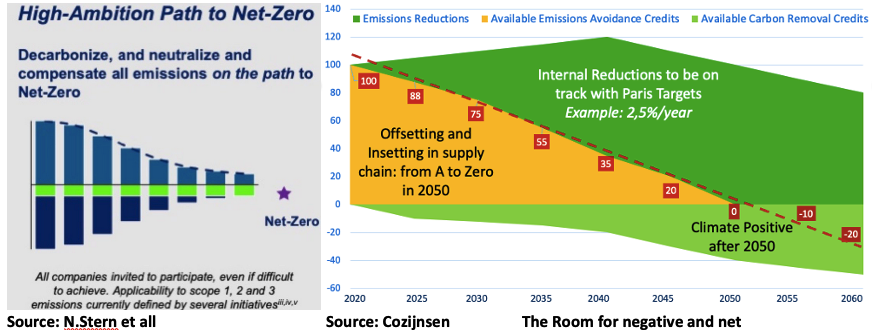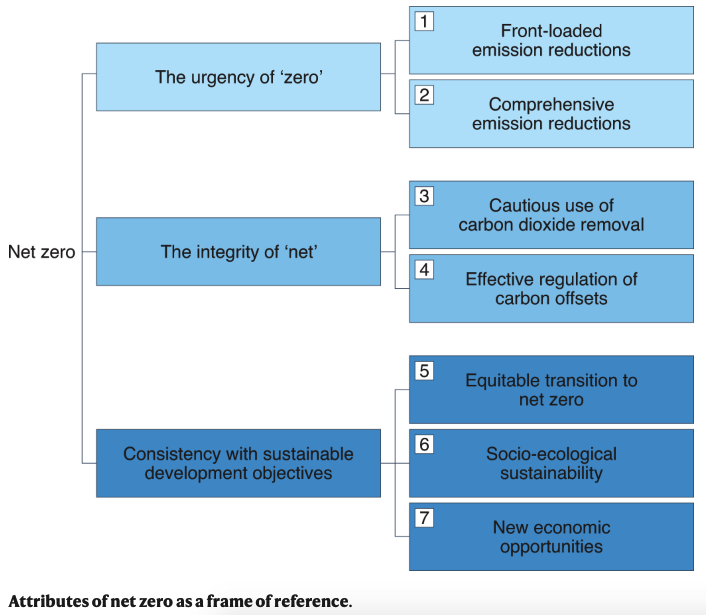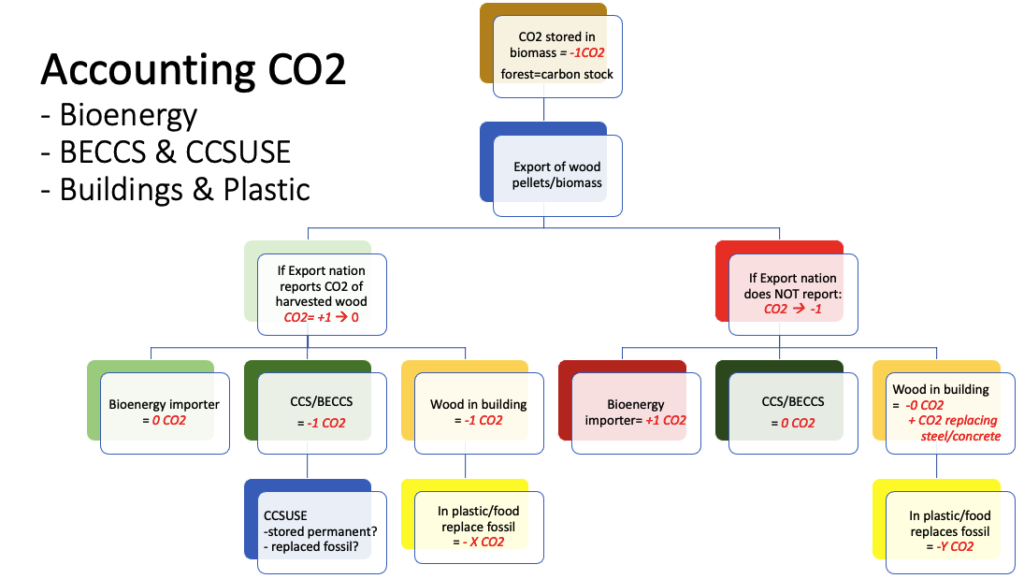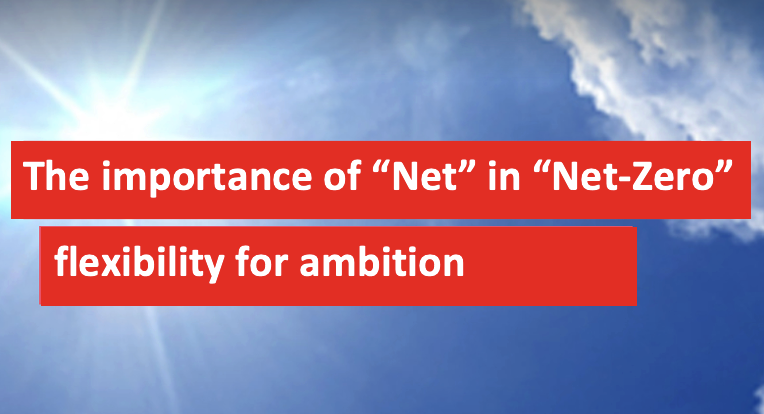Eventually all global emissions must be zero but we can win time with a “net” approach if we do a proper climate accounting. The report of Working Group III of the IPCC says “meeting the long-term temperature objective in the Paris Agreement implies a rapid turn to an accelerating decline of greenhouse gas emissions towards ‘net zero’” It says also using ‘carbon removal is unavoidable’ and the cost, for natural capture like soil carbon will decline as projects are scaled up. IPCC also acknowledges carbon trading and investing in offsets drived emissions reductions in energy, industry, land sector, buildings and transport. In general the report says that offsetting can lead to ‘faster overall emission reductions beyond to what is possible with emissions reductions under direct control of a company.; The IPCC concludes (Chapter 14) that carbon trading under the Paris Agreement (Art 6.2: Internationally Transferred Mitigation Outcomes, ITMOs) can lead high higher ambition and lower cost of abatement.
IPCC: Carbon trading under the Paris Agreement (Art 6.2: Internationally Transferred Mitigation Outcomes, ITMOs) can lead to higher ambition and lower cost of abatement
So, how can countries become net climate negative in 2050 and how can carbon trading play a robust role? The ‘net’ offers the necessary flexibility to achieve the ambitious goals. It is not a weakening, as some say. In this article I explain how any concerns can be tackled and how the concept actually leads to more climate ambition.What is the rationality behind ‘net-zero’? And what are the sensitivities?
- Net zero CO2 emissions: Condition in which anthropogenic carbon dioxide (CO2) emissions are balanced by anthropogenic CO2 removals over a specified period.
- Carbon neutrality and net zero CO2 emissions are overlapping concepts
- The quantification of net zero CO2 or net zero GHG emissions depends on the GHG emission metric chosen to compare emissions and removals of different gases, as well as the time horizon chosen for that metric.
- In some cases achieving carbon neutrality may rely on the supplementary use of offsets to balance.
- A situation of net negative greenhouse gas emissions is achieved when metric-weighted anthropogenic greenhouse gas (GHG) removals exceed metric-weighted anthropogenic GHG emissions.
The rationality of net zero
The rationale behind the ‘net-zero’ goals is that by 2100 the world will eventually have to find a balance again in natural greenhouse gas emissions and their storage in biomass and oceans. Western industrialized countries and large companies must take the lead in this and achieve that balance by 2050. But because it may not be possible to completely eliminate all own greenhouse gas emissions – think of methane from industry, agriculture, harbor sludge and peatlands – additional reduction or carbon storage can be realized in other sectors, or other countries. If this is properly accounted for, this will lead to an overall net-zero emissions result (see also IPCC definitions). And the total result contributes to global emissions reduction.
And as long as there are still countries and sectors, that cannot or did not yet achieve zero emissions themselves, by 2050, and of course, developing countries have more time to reduce, other countries and companies can finance additional reductions there, so that the global total will reach 0 more quickly. The agreements in Glasgow on the use of the CO2 market help to make this international exchange possible in terms of additional reductions.

Possible concerns with the concept
The concern of environmental organizations in particular, is that companies abuse the ‘net target’ concept and continue to use fossil fuels for too long and seek compensation in expensive, unproven techniques such as ‘Direct Air Capture’: see also critical study by New Climate Initiative. There are also differences in targets they set: sometimes only CO2 or all greenhouse gases in CO2 equivalents. And it also matters a lot which time scale is used. Can one invest in CO2 sequestration in planting trees that decay after say 40 years and contribute to CO2 emissions, but can it be subtracted from CO2 emissions from fossil fuels that remain in the atmosphere for 100 years? And methane will have a 28 times greater effect than CO2 over 100 years, but in the short term more than 80 times greater effect. In addition to CO2 and other greenhouse gases, total warming occurs also due to other effects, such as the extra impact of aircraft at high altitudes. And the deposition of soot from shipping in the Arctic also means extra warming. So, when countries and companies set goals, those aspects must also be taken into account.
Prioritizing emissions reduction does not equate to ‘reduction only, nor does it mean that carbon removal should be postponed
Some therefore argue in favor of giving all greenhouse gases and all sectors their own CO2 targets and not allowing any exchange or fungibilty. Others argue that compensation is only possible with ‘carbon removals’ and not through ‘avoidance of emissions’. The Science Based Targets Initiative (‘compensation beyond value chain mitigation in contrast to neutralisation, which is the term for removing residual emissions’) tends to support this. SBTi itself is criticized by NGOs and in research as not meeting promises and not independently validating and enforcing plans and action from companies.
Blocking fungibility of reductions, the ‘net’ approach, seems unwise to me. For greater ambition, and given the fact that not all sectors and countries can go to 0 equally quickly, and since there are a few affordable carbon removal projects available in the short term, this flexibility between sectors, gases and also between countries is indispensable. “Prioritizing emissions reduction does not equate to ‘reduction only’, did researchers write, ‘nor does it mean that carbon removal should be postponed’. And in the interest of preserving biodiversity alone, the West must for example help developing countries protect the rapidly disappearing tropical forests and mangroves.
So, how to get it right!
In Nature, scientists describe what exactly net zero means, and how to makes that part of an integrated approach: “The meaning of net zero and how to get it right” and they propose that rich countries reach net zero before and after. net negative. In Nature, scientists identify 7 features of net zero that are important for making it a successful framework for climate action.

Before one can make the claim of CO2 neutral bioenergy and apply CO2 negative BECCS you need to determine whether the exporter of the waste wood pellets has previously reported those as CO2 emissions for ‘harvested wood products’
The above concerns mentioned can be tackled well
- By scrutinizing corporate net-zet targets and ensuring that companies commit to ‘Paris Proof’ or ‘Science Based Targets’. The UN Secretary General set up a High-Level Expert Group on Net-Zero Commitments of Non-State Entities from biz to investors to cities, chaired by former Canadian Env minister Catherine McKenna. Each pledge must deliver ambitious, real, immediate reductions in transparent, verifiable way. Companies can do that for example through a 50% reduction of own CO2 emissions and 20% in emissions in the supply and sales chain in 2030. In the Dutch Shell judgment, the Court imposed a reduction of 45% compared to 2019. Another example is the Climate Neutral Certified Standard by Climate Neutral Group, that imposes a CO2 target on emissions of 50% in 2030 and absolute zero in 2050. Such reduction targets ensure that the compensation with ‘offsets’ is really additional. Moreover, all the remaining emissions below the cap have to be compensated. So climate neutrality into the own emissions are zero in 2050 result in cumulatively
- There is indeed an asymmetry between the lifetime of CO2 in the atmosphere and the permanence of CO2 storage in trees. In the long run, a tree does not compensate for coal. This can be overcome by capturing, say, 10% extra CO2 in forests, suggested the IPCC (IPCC AR6, D.1.5.) or by ensuring that forest stocks, and thus carbon stocks, are preserved. Then the forest growth makes good for 100% offset .
- If you capture the CO2 from biofuel combustion and then store it in the soil or empty oil or gas fields (#BECCS), this counts as negative CO2 emissions. In the latest report of the IPCC the potential is modelled as smaller, to meet biodiversity and food security demands, but still 30-780 GtCO2, using 199 million ha forest in 2100. But before one can make the claim of CO2 neutral biomass and apply CO2 negative #ECCS you need to determine, scientists recently wrote, ‘whether the exporter of the waste wood pellets has previously reported those as CO2 emissions for ‘harvested wood products'” according to the rules of the Paris Agreement (See “Assessing the potential for unaccounted emissions from bioenergy and the implications for forests: U.S and Global”. If that is the case, it counts as CO2-neutral in the country of use for power generation and CO2-negative after storage (see figure below for the accounting of bioenergy and BECCS). As the study shows the accounting of exported harvested wood products is sometimes not clear.
- On the other hand, you can compensate extra if you reduce methane. That is already broken down after 10 years, but in that time it has more than 80x greater warming than CO2: so early reduction of methane can be seen as overcompensation (IPCC AR6, D.1.7.). IPCC and the Climate Summit in Glasgow have therefore called for early methane reduction.
- Direct Air Capture is still an expensive option (200-1000 euros per ton of CO2) and has not yet been proven. CCS is cheaper, as of 60 euros per ton, but there is still little experience with that. So a net zero goal shouldn’t depend too much on these options.
The net approach works and has large potential
With the above approach, a net approach leads to more flexibility and more ambition. Of course, eventually all emissions must be zero and there must be sound climate accounting. But with a net approach, no time is lost. And research by Ecofys for the World Bank showed that costs will be a third lower in 2030 if the global CO2 market is partly used, and 50% lower in 2050. Researchers from the University of Maryland estimate the potential for reductions in fossil emissions of 5 Gton in 2030 and naturally based reductions and removals at 4 Gton in CO2.

